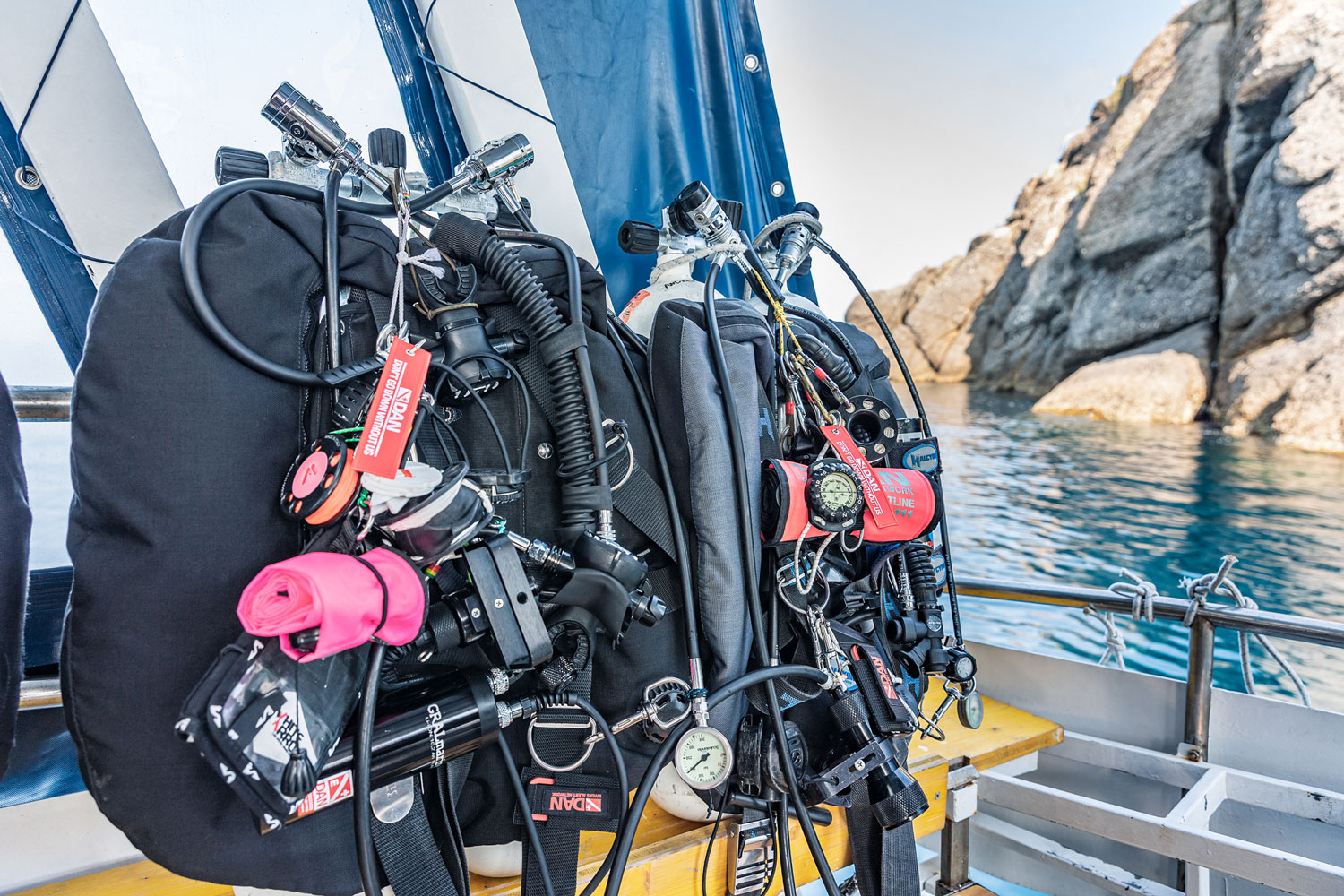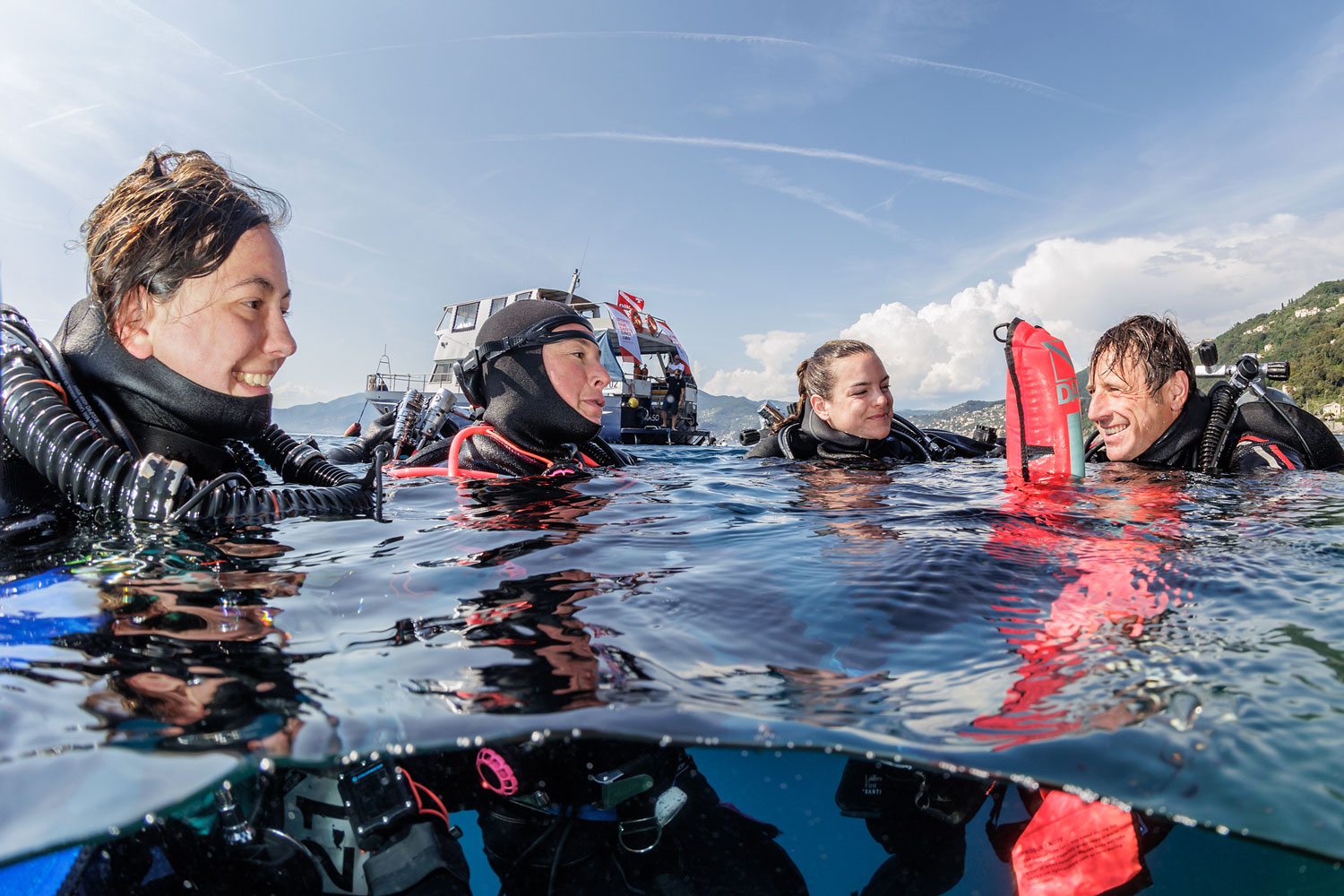Prepared diver
Everything You Always Wanted to Know About Teaming Up With a Rebreather Diver
Open-circuit and rebreather divers can be on the same team – to the benefit of both parties, as long as certain precautions are observed.
With rebreathers gradually becoming more popular, the odds of encountering one on the boat or on a dive trip are increasing. Maybe your buddy took the plunge and got trained on one of the excellent new units that have come on the market in recent years. Or maybe you’re curious about how a rebreather works, and what it looks like when someone uses this kind of equipment on a dive.
Whatever your motivation may be, aside from getting trained yourself, there is no better way to learn about rebreathers than to go diving with a buddy who uses one. However, there are some considerations with regard to safety and procedures that need to be addressed when open-circuit divers team up with rebreather divers.
First, a little bit of terminology: At Rebreather Forum 4 in Malta this year, Mauritius Valente Bell, a highly accomplished research diver and Dive Safety Officer at the California Academy of Sciences, gave an interesting and thought-provoking talk on what is known as mixed-mode and mixed-platform diving.
Mode, in this context, refers to the basic method of diving, for example open-circuit SCUBA, rebreather, the surface-supply systems used by commercial divers, or apnea diving. Platform refers to the specific model of rebreather used. So, in the jargon, what we’re talking about when you’re an open-circuit (OC) diver teaming up with a closed-circuit rebreather (CCR) diver, is mixed-mode diving.

In his presentation, Bell laid out a variety of reasons why rebreather divers might choose to dive in mixed-mode teams. These reasons include buddy availability and opportunities to practice when no other rebreather divers are around, as well as having OC divers in support roles for deep or complex dives. For OC divers, the key benefit of teaming up with CCR users would be an opportunity to learn about rebreathers and observe them in action.
However, there are also considerations: Most divers don’t know a lot about rebreathers in general. On top of that, different rebreather models (platforms) can be quite different in the way they operate, so that familiarity with one doesn’t necessarily transfer to another. Yet in order to be useful as a dive buddy or teammate, one needs to understand the equipment of the other members in the team. Dive briefings for mixed-mode teams therefore need to cover a few additional items compared with OC-only briefings.
It should also be noted that mixed-mode diving isn’t for beginners. If you don’t yet have the skills or experience to assist another open-circuit diver in an emergency, then you won’t be very helpful to a CCR diver should they get in trouble. As always, if you don’t feel comfortable about a certain dive, the responsible thing to do is to speak up and, if no viable alternatives present themselves, bow out.
Equipment overview
Before you get into the specifics of the dive, you would like to have a basic overview of your buddy’s rebreather so that you will be able to understand what’s going on. Fundamentally, any rebreather consists of a breathing loop with counterlungs, a CO2 scrubber, a mechanism for adding gas(es), and a device for monitoring the oxygen content in the loop. These components are combined with equipment that any diver needs, namely cylinders and a buoyancy device of some description.
There is considerable variation between different rebreather platforms as to how exactly this is implemented, and the technology (either because it’s so involved, or because it’s so simple and elegant) can be quite fascinating. It is therefore a good idea to keep this overview separate from the actual dive briefing, as there’s a substantial risk that you and your CCR buddy will get lost in the details and delay everyone.

Gas planning and emergency procedures
The nice thing about being a CCR diver is that you have virtually infinite gas (for most purposes) as long as your rebreather works. For the event that it stops working, a CCR diver must carry enough OC bailout gas to end the dive from any point. While bailout gas calculation for CCR has a lot of parallels with reserve planning for open circuit, it isn’t the same thing. Also, as with OC gas planning, not everybody does it the same way. Before any dive, have a discussion within the team and make sure that everybody’s reserve requirements are met.
You also want your CCR buddy to walk you through the process of donating gas to them – for example, they need to close their mouthpiece before they can accept a second stage from you – and you want to know where the gas they’re donating to you in an emergency is coming from. As a rule, it will be (one of) their bailout cylinder(s), and you want to be familiar with its location. It’s probably not a bad idea to do a couple of dry runs for practice.
As for other emergencies, there are potential problems with breathing gas composition (namely hypoxia, hyperoxia, and hypercapnia) that are specific to rebreathers and play much less of a role in OC diving. To dive with buddies who are on CCR, you want to discuss these and the proper response to each of them (which may vary depending on the configuration of the rebreather).
Finally, maintaining team cohesion requires a little extra care in a mixed-mode group: When your open-circuit buddy is taking pictures behind some rocks, you can often spot them quite easily by the trail of bubbles making its way to the surface from behind said rocks. Not so with a rebreather.
Decompression
When diving open circuit, gas switches are points in the decompression schedule where the partial pressure of inert gas in your inhaled gas drops considerably. As an example, for a dive with air and EAN 50 (used for simplicity here, not because air is a great gas for deco diving), the partial pressure of nitrogen (PN2) drops by more than 40% when ascending from 24 m to 21 m and switching to the 50% bottle (3.4 ata * 0.79 = 2.69 ata at 24 m vs. 3.1 ata * 0.5 = 1.55 ata at 21 m). When ascending to the 18-meter stop, the change is a mere 10%, from 1.55 to 1.4 ata.
Rebreather divers on the other hand keep a constant PO2 at all stages of the dive, which makes the decrease of inhaled PN2 much smoother throughout decompression. As a result, the optimal decompression schedule for a rebreather diver will be different from the optimal decompression schedule for an open-circuit diver when everything else (depth, bottom time, model parameters like gradient factors) is held constant. This difference needs to be taken into account when planning deco dives in mixed teams.
Timing
If you’ve never buddied up with a rebreather diver before, then one thing that will surprise you is how excruciatingly SLOW these people are. With EVERYTHING. When everyone else grabs a cylinder and a spot on the boat first thing after arriving at their travel destination, a rebreather diver typically spends a day assembling gear, getting gas fills, packing their scrubber, running the checklist, partially disassembling and reassembling their gear, re-running the checklist, making adjustments… you get the idea. An abridged version of this process takes place before each and every dive.
During the dive, the picture is similar. Rebreather users take extra time on the surface to don bailout cylinders and do bubble checks. When descending, some OC divers like to completely dump all the air from their BC and drop to the target depth like rocks. Regardless of how good or bad an idea this is to begin with, you simply can’t do it when there’s a CCR diver on the team. Their maximum descent rate is slower because they need to manage their breathing loop volume and oxygen content. 15 m/min is considered quite speedy. Their ascent rate is slower as well, because they need to vent gas from the loop, add oxygen to maintain the proper gas composition, and readjust their buoyancy at regular intervals.
Do not try to rush a CCR diver. Rebreather users make up about 10% of the world’s dive fatalities every year, a disproportionately large share if you consider how few rebreathers there are. Thoroughness is what keeps us alive. If you’re impatient, go on a dive with someone else first and come back later.
As with every rule, there are exceptions. When you meet a CCR diver who always seems to be ready on time and rarely has issues with their gear, take note. There’s probably a thing or two to be learned from them.
About the author
Tim Blömeke teaches technical and recreational diving in Taiwan and the Philippines. He is also a freelance writer and translator, as well as a member of the editorial team of Alert Diver. He dives a Fathom CCR. For questions, comments, and inquiries, you can contact him via his blog page or on Instagram.


